Last Updated: May 15, 2024
If you’re looking for picturesque beaches, wild jungle, and up-close encounters with wildlife, Manuel Antonio National Park is for you. Our first visit to Manuel Antonio’s famous national park was over 15 years ago. It had a handful of trails then and was a wonderful place to go for calm water and swimming. Now that we live in Costa Rica, we visit often and have noticed many improvements over the years. In this post, we’ll talk about the hiking trails and gorgeous beaches. We’ll also give tips for spotting wildlife and avoiding the crowds.
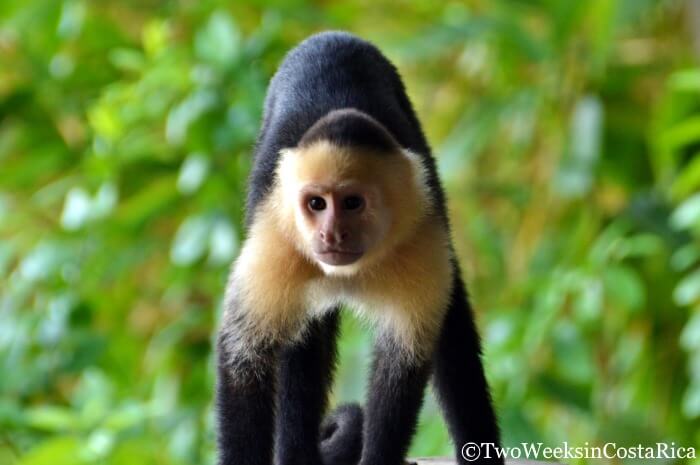
Arriving at Manuel Antonio National Park
Location
Manuel Antonio National Park is located off the main road between Quepos and Manuel Antonio, close to where the road ends by the beach.
The entrance has changed over the years. For several years now, it has been behind the main road. Once you get to the beach, look for a left turn near a small grocery store, some souvenir shops, and Marlin Restaurant.
Parking
Parking in this area is limited so you will need to pay a small fee to use one of the lots. A good option is the large lot on the right-hand side before the national park gate. The fee is 4,000 colones (about $8) for the day.
Tip: As you drive down the hill and approach the beach, you will likely encounter some people in the road trying to get your attention. They might step into the road and ask you to stop or even whistle at you. They are just trying to get you to park in their lot. They are not park or any other type of official. You don’t have to stop and there are a few different parking options available so feel free to drive around first. You can always turn around at the end of the road where it loops back.
Hiking in Manuel Antonio National Park
Overview
Manuel Antonio National Park has several options for trails. It’s a great spot for families and casual hikers. Many of the trails are flatter and suitable for most people, but some do have steeper inclines. We’ll discuss each in more detail below.
No matter how much hiking you can do, though, the great thing about this park is that it makes nature discovery easy. You will feel immersed in the rainforest and see a good amount of wildlife even on the easy trails. We have brought our older parents here and sent elderly clients, and they were all able to do many of the trails.
Here is a link to the trail map to help you plan.
El Manglar Trail, Perezoso Trail, and Main Trail/Road
The first trail you come from the ranger station is the new El Manglar Trail (Mangrove Trail).
It is really interesting because it has a raised platform that you can walk on, instead of the ground. This makes it a good option for almost anyone, including people with limited mobility or a wheelchair. The platform is wide, stable, not slippery, and nice and flat. There are even some resting benches and covered areas along the way.
El Manglar Trail meanders through the forest and then gives you a few different options.
The first you’ll come to is a cut through to access the Catarata Trail (see below). If you stay on El Manglar instead, you’ll come to a point where it breaks off to the right into the mangroves. We’ve heard from our friend who is a guide that sometimes you can see crocodiles in this stretch so it’s worth the short walk.
El Manglar leads to the beautiful quiet beach, Playa Espadilla Sur (more below).
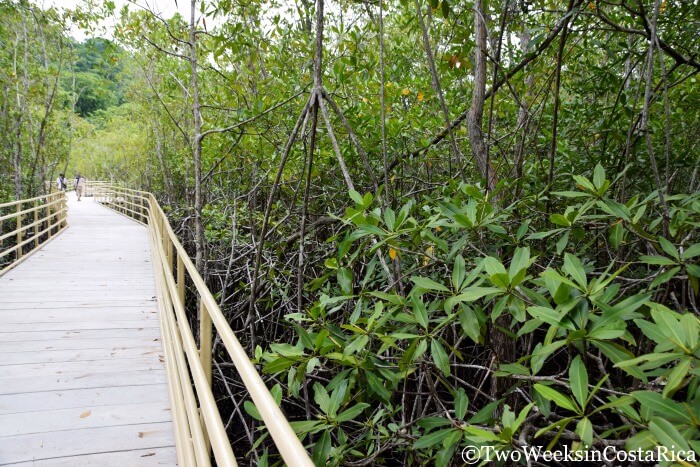
If instead of going right towards the mangroves, you stay straight, you will get on the Perezoso Trail (Sloth Trail). Many people use this as a fast way to get to the park’s most popular beach, Playa Manuel Antonio. We’ve seen howler monkeys multiple times here. This trail is very short (0.36 miles/580 meters), paved, and has some a steeper section but isn’t too hard.
Paralleling El Manglar is the main trail/access road. This wide dirt road is flat and rocky. It brings you to the same point as El Manglar/Perezoso Trail, near the main beach. Tour guides often bring bigger groups here because there’s a lot room for everyone.
Catarata Estacional Trail (Seasonal Waterfall Trail)
We mentioned this one above. The Waterfall Trail is the first one off the main trail so we recommend doing it at the beginning of your day.
If you’re coming in the rainy season (May to November), this would be a good one to check out. The waterfall is small, but still pretty. You’ll notice that the water looks cloudy. This is due to the presence of minerals like calcium from coral and shells.
If you’re not visiting in rainy season, you could skip this trail since the waterfall often doesn’t have much water in the dry months.

We have seen a lot of wildlife on the Waterfall Trail when visiting in the rainy season.
We saw a three-toed sloth high up in a tree, a blue morpho butterfly, a green and black poison dart frog, many Halloween crabs (named for their orange and black color), a stick bug, and even a tiny red-eyed tree frog at the trail entrance.
This trail is concrete and only 0.42 miles (676 meters). It has some steeper sections with stairs (up to 50 at a time) and is easy-to-moderate in difficulty.
Miradores Trail, Playa Gemelas Trail, Puerto Escondido Trail, and Los Congos Trail
This is our favorite set of trails at Manuel Antonio National Park because we always see a lot of wildlife. They are all located in one area and are connected so perfect to do together.
The trail starts next to the cafe/restaurant where the Perezoso Trail and main trail drop you off.
A nice loop is to start with Miradores (Viewpoints Trail), then cut over to the Playa Gemelas/Puerto Escondido Trail by using Los Congos Trail.
Attractions and Trail Conditions – Miradores/Gemelas/Puerto Escondido Loop
The Miradores Trail takes you to a couple of different viewpoints. The first one is a distant lookout to Playa Manuel Antonio, but the second is beautiful.
This viewpoint looks out to the marine portion of the national park as well as the rich green Punta Serrucho. This narrow stretch of craggy coastline juts way out into the ocean. Its name, Saw Tip, describes its broken and irregular shape, which was caused by the shifting of the earth as it sits on a tectonic fault.
To get up to these viewpoints, it takes some hiking. The Miradores Trail is short (0.6 miles/1 km), but there is a series of concrete and wooden stairs, around 300 in each direction.
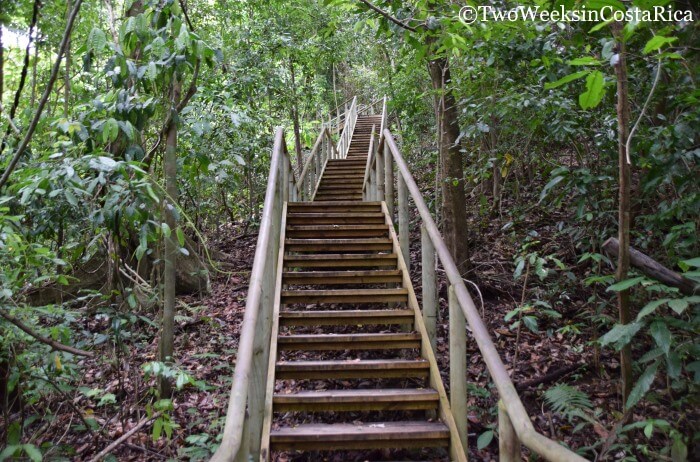
As you’re coming back on the Miradores Trail, take a left onto Los Congos Trail (Howler Monkeys Trail). This very short trail serves as a shortcut to the Playa Gemelas Trail. But it is a fun one. Years ago, this trail was very narrow and the jungle was so thick, you had to duck in places. Now, it is a well paved path, but still feels wild. Howler monkeys usually can be heard bellowing overhead.
At the end of Los Congos, you’ll reach the Playa Gemelas Trail, which turns into the Puerto Escondido Trail (Hidden Port Trail) (0.46 miles combined/740 meters). From this point, it’s a short walk to the main attraction.
After walking down about 140 steps, you’ll come to a platform just above sea level with a view of Puerto Escondido. At low tide, you can see a sandbar that connects the mainland to the small island right offshore.
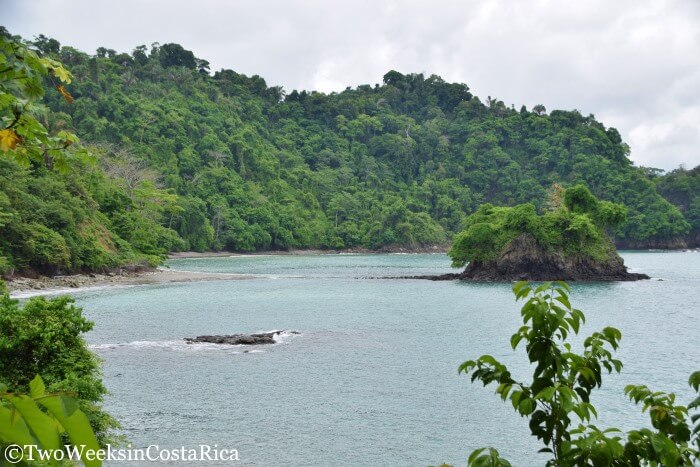
Unfortunately, you can’t get down to this beach. But you can swim at Playa Gemelas on the way back to the main trail. Because fewer people access these trails, Playa Gemelas is usually quiet and peaceful.
Wildlife – Miradores/Gemelas/Puerto Escondido Loop
We have consistently seen a lot of wildlife on this set of trails. We’ve spotted all three types of monkeys that live in Manuel Antonio National Park (howlers, white faced, and squirrel), sloths, deer, and many kinds of lizards including green spiny lizards.
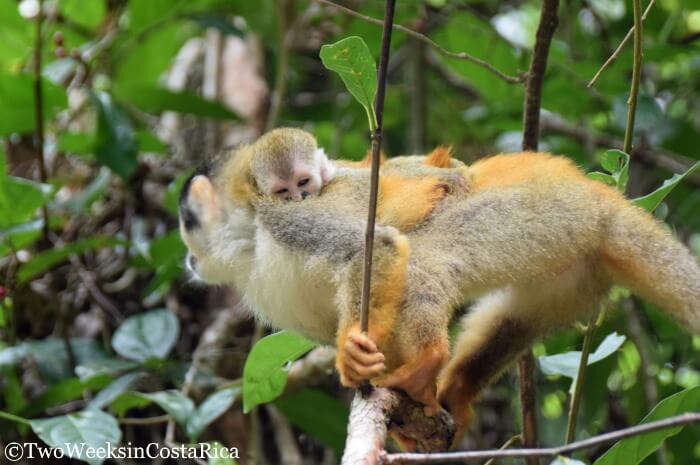
We have also seen a number of birds. Some of the highlights include Black-throated Trogons, woodcreepers, Chestnut-Mandibled Toucans, and aracaris (a relative of the toucan). This colorful Fiery-Billed Aracari surprised us on our last visit by landing on a branch right next to the trail!
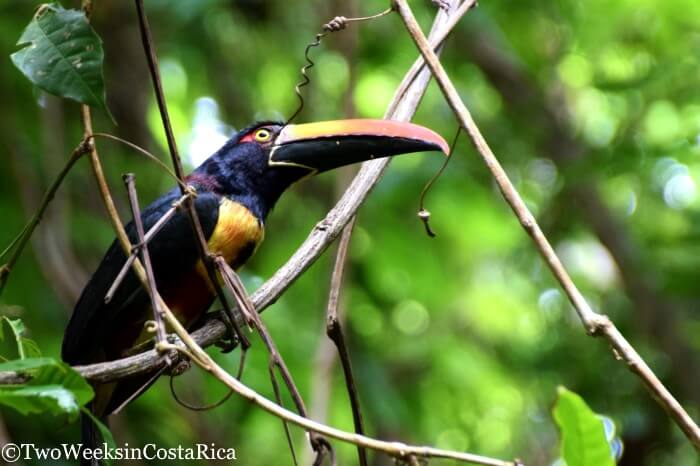
For more cool animals you might see, read out post: The Wildlife of Manuel Antonio National Park
Punta Cathedral Trail
Punta Cathedral Trail (Cathedral Point Trail) lets you walk out on the famous tómbolo.
This unique rock formation is a natural bridge, connecting the mainland with Punta Cathedral. You may have seen it featured in some of the advertising for Manuel Antonio.
Even though this trail is right next to the beaches, not many people do it. It’s also nice because it takes you through thicker jungle. As you curve along the path, following the shape of the point, you will be taken up to a few viewpoints. They look out to the ocean in different directions and to small islands like Isla Olocuita.
You can see birds and some wildlife along this trail since the forest is thick. A few years ago, we saw a helmeted iguana for the first time here. These lizards aren’t too common so we were thrilled to find one.
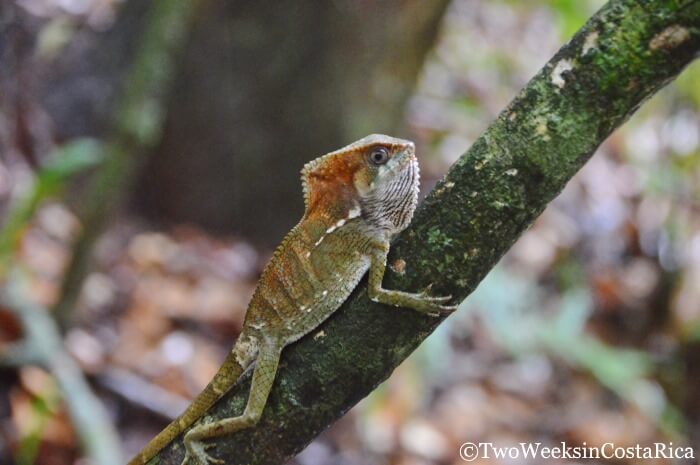
Punta Cathedral Trail has some gradual inclines with stairs and is easy-to-moderate in difficulty (0.75 miles/1.2 km).
Beaches in Manuel Antonio National Park
Many people visit Manuel Antonio National Park just for its beautiful beaches.
The most famous is Playa Manuel Antonio.
This is a stunning cove with shimmering aquamarine water and ivory sand. With lots of shady almond trees, this beach is perfect for a day of lounging around with a good book. The calm water and sandy sea floor make it a great spot for swimming too. On days where the ocean is flat, the rocks on the left are a fun spot for casual snorkeling (bring your own equipment).
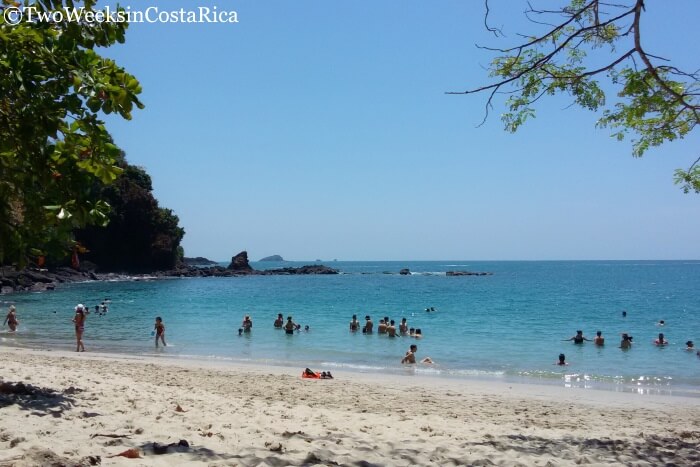
Playa Manuel Antonio can get crowded, but just around the corner is Playa Espadilla Sur. This beach isn’t quite as picturesque as Playa Manuel Antonio, but is still lovely and having it all to yourself may be worth it.
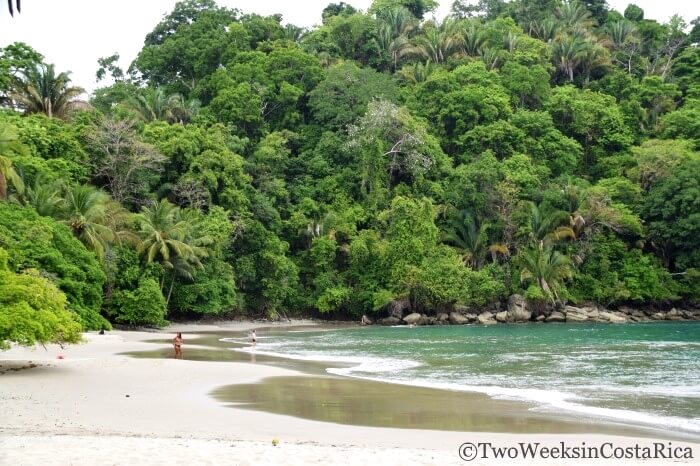
Watch Out for the Monkeys
Troops of white-faced monkeys are known to come down to the beach and around the cafe for handouts. We’ve seen them break into the backpacks of unassuming tourists many times, so always keep your belongings in sight. This also can happen with raccoons.
You’ll may see people feeding the monkeys on your visit.
Resist the urge to do so to keep the monkey population safe and healthy. Monkeys are extremely sensitive to the bacteria on human hands and can become sick or even die by eating foods that people have touched. Human food is also not as nutritious as their natural diet and eating handouts can cause problems for nursing mothers and their babies.
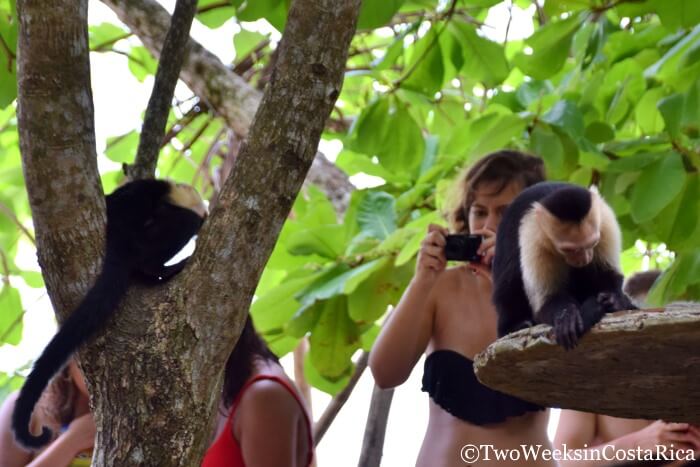
Do You Need a Guide?
Exploring the park on a guided tour is a great option if you want to learn more about the local flora and fauna. A guide will teach you about the native plants and animals and spot hidden wildlife with their trained eye.
Guides also have powerful scopes that can get you up close and personal with an animal without disturbing it (we’ve even seen the green algae growing in the fur of a slow-moving sloth high up in a tree!).
Most guides also will use your cell phone to take close up shots of the animals through their scope. Check out our post about using naturalist guides if you’d like more information.
If you’ve hiked in Costa Rica before, though, you can probably manage by yourself as the trails are well marked and wildlife is fairly easy to spot.
Booking a Good Guide
Every day people are lined up near the park entrance offering guide services, but many of them are not certified naturalists.
If you would like help booking a reputable guide, we know an excellent company. Their guides are locals from Manuel Antonio and have been guiding tours for many years. They are certified by the Costa Rica tourism board (ICT). Our clients always come back saying what an amazing time they had and are astounded at the wildlife they saw.
Use the link below to request a booking. You won’t pay until your reservation is confirmed. Booking through us costs the same and helps support our website!
Tour Price, Group Tour (8 people max): $59 adults | $50 children ages 5-11 | $6 children ages 2-4 | kids under 2 are free.
Tour Price, Private Tour: $95 per person | $6 children ages 2-4 | kids under 2 are free.
Tour Times: 7:30 a.m. or 12:30 p.m. every day except Tuesday (park is closed)
Duration: About 3 hours
Includes: Bilingual naturalist guide, entrance fee, round-trip transportation from your hotel or vacation rental in Manuel Antonio, water, and a snack.
Avoiding the Crowds
Manuel Antonio National Park is one of the busiest parks in Costa Rica and can feel a bit like Disneyland at times during the high season.
Our advice is to arrive early to avoid the crowds, especially on weekends and holidays.
Big tour groups typically start showing up around 9:00 a.m., so it’s best to get there closer to when the park opens at 7:00 or 7:30 a.m. Note that in an effort to limit impacts on local wildlife, the number of visitors per day is capped and there are often lines to get in.
Tip: Manuel Antonio National Park is so popular because it’s good for anyone, kids and people with limited mobility included. If you’re looking for something less busy and a little more rugged, we recommend Rainmaker Nature Park. For more info, read our post, Rainmaker Conservation Park: Unspoiled Nature Near Manuel Antonio.

Cost
Rates current as of May 2024.
Foreigners: Adults – $18.08. Children ages 2-12 – $5.65. Children under 2 are free. (prices include 13% tax)
Costa Rican Nationals and Residents: Adults – ₡1,808. Children ages 6-12 – ₡565. Children 5 and under are free. (prices include 13% tax)
Buying Your Tickets
Official SINAC Government Website
If you’re visiting on your own, you can purchase tickets online directly from the Costa Rican government, SINAC. We recommend booking them through this site rather than through a third-party website.
First, create an account on the SINAC government website.
Once you are logged in, click “Buy” and select “Online Reservation.”
Next choose the wildlife area, “Parque Nacional Manuel Antonio.”
Choose your date. For the time, you have to select a specific timeslot to enter. Options are for example 7:00 a.m.-7:40 a.m., 8:00 a.m.-8:40 a.m., and so on.
Select the number of adults/children.
Click “Continue.” You will be taken to a payment screen to enter your credit card details (you have 10 minutes to complete the transaction).
Once you complete the transaction, a confirmation will be emailed to you. Keep this to show the park ranger when entering. They will need the verification number from the reservation to look you up in the system.
Other Websites
*Watch out for websites claiming to be official ticketing agents.
SINAC is the official ticketing agent so it’s best to buy directly from them. If you plan to go with a guide, usually the guide will purchase tickets for you. They will need your full name, nationality, and passport number to do so.
You can find all official information about Manuel Antonio National Park on the SINAC website. SINAC is the government agency in charge of Costa Rica’s national park system.
Park Hours
Manuel Antonio National Park is open every day of the week, except Tuesdays, from 7:00 a.m. to 3:00 p.m.
Previously the park was closed on Mondays; however, the day was changed to Tuesday starting on April 1, 2021 in order to promote local tourism on long weekends.
Food Options and Plastic Bottles
Prohibited Foods
No food can be brought into the park.
This is to protect the wildlife, in case they get ahold of your bag. In the past, this has been a big problem with monkeys and raccoons.
The park rangers will search your bag upon entry and confiscate all food.
Babies and pregnant women are allowed to bring in a limited amount of food.
Cafeteria
Inside the park, there is now a casual cafe with food for purchase. It is located at the end of the main trail/road near the beach. There are some tables set up outside the cafe to eat at.
The cafe serves:
- Pizza
- Simple sandwiches (ham and cheese, tuna, or chicken)
- Burritos (vegan)
- Fresh fruit
- Some baked goods like empanadas, cheese croissants, cinnamon rolls, and cake
- Salads
- Soda, coffee, and natural fruit drinks. You can refill your water bottle here too.
- Ice cream
They also have some souvenirs and sell basic snorkel masks.
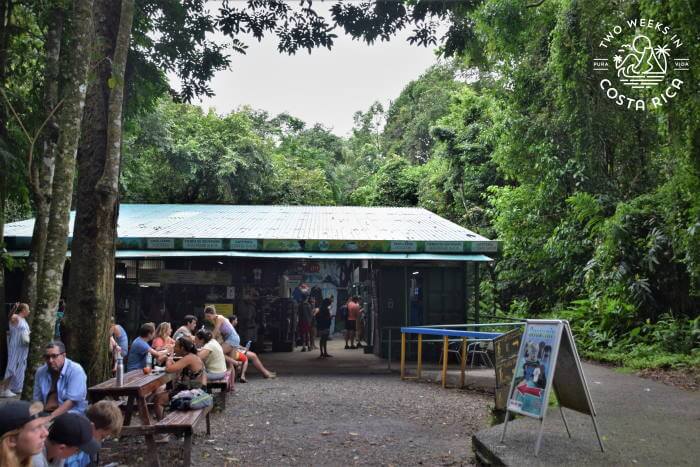
Single-use Plastic
Costa Rica has banned the use of single-use plastic bottles and plastic food containers in all national parks. So be sure to bring a reusable bottle to refill. Park officials will not allow single use plastics through the gate.
Last Updated: May 15, 2024
Have questions about visiting Manuel Antonio National Park? Ask them below. We’d love to help you plan your visit.
Looking for more info on Manuel Antonio? Check out these posts:
Manuel Antonio Trip Planning: Destination guide, includes detailed info on the best time to visit, how to get there, as well as recommended hotels, restaurants, and activities.
7 Off-the-Beaten-Path Things to Do Near Manuel Antonio: Ideas for days trips from Manuel Antonio, including a chocolate and spice farm tour and more options for hiking.
Packing for Costa Rica: The Essentials – Takes the guesswork out of packing. Tips on clothing, gear, and footwear. Includes special considerations for travel to remote destinations and during the rainy season.

